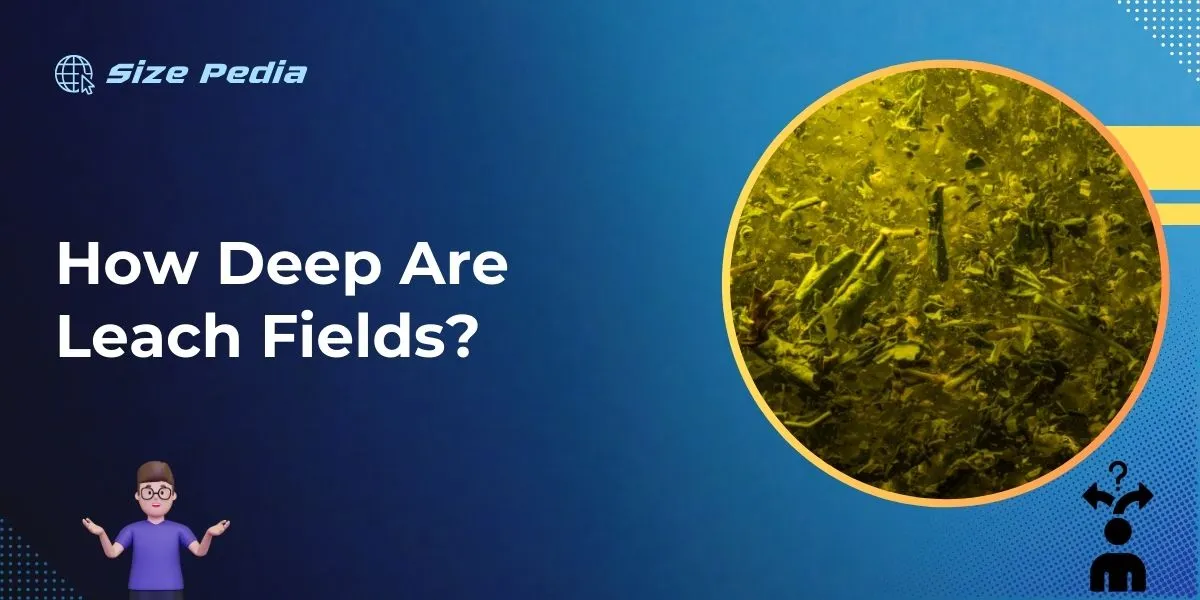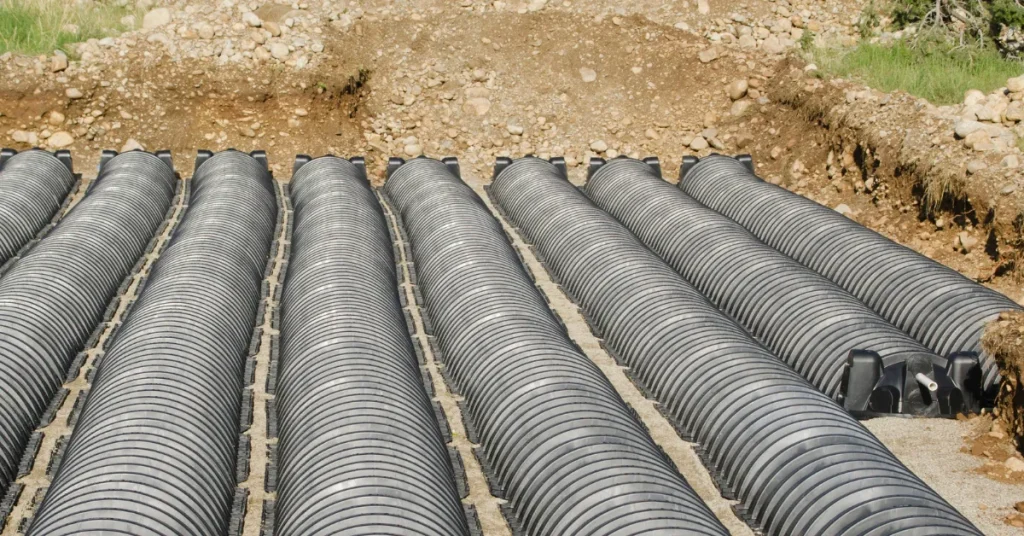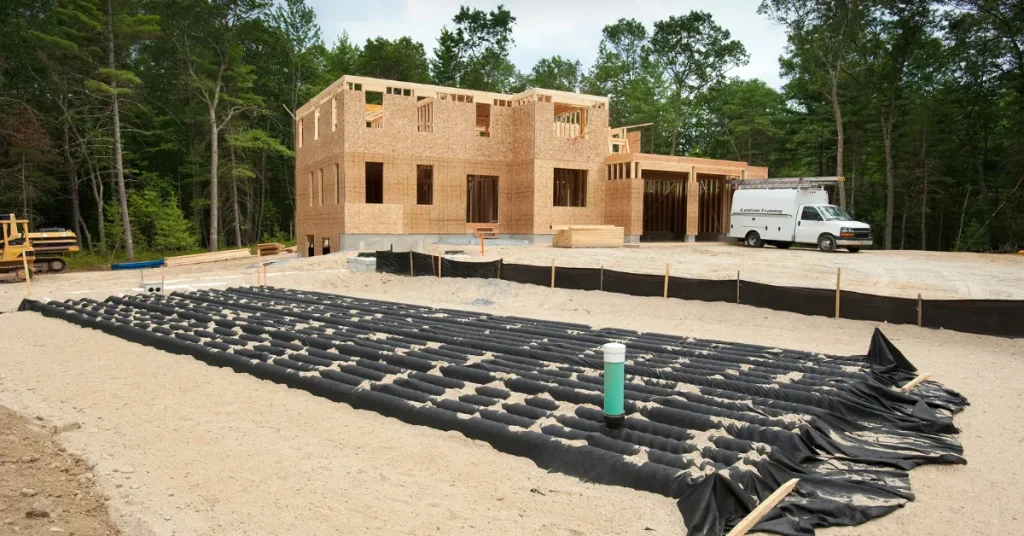Leach fields are typically 18 to 30 inches deep. They must accommodate the depth of the septic tank’s outlet pipe.
Leach fields, also known as drain fields, play a pivotal role in the septic system, treating wastewater by allowing it to percolate through soil. Proper depth is crucial for their function, as it facilitates the treatment of effluent by soil microorganisms.
This depth ensures adequate filtration before groundwater is reached, minimizing the risk of contamination. Homeowners and installation professionals must respect local building codes, which specify depth based on soil conditions and environmental regulations.
Careful consideration of leach field depth not only ensures system efficiency but also protects public health and the environment.

Decoding Leach Fields
Welcome to the enlightening world of septic system components, where we unravel the secrets of how deep leach fields go.
This component is crucial to the health of your home’s waste management system. So let’s decode leach fields. Understanding the intricacies is vital for proper maintenance and functionality.
The Role Of A Leach Field
A leach field is an essential part of the septic system. It’s where the final treatment of wastewater happens before the clean water returns to the soil.
Think of it as a final checkpoint that ensures only clean water makes its way back into the earth. By spreading out wastewater, it helps avoid clogs and keeps your system running smoothly.
Components Of A Typical Leach Field System
The typical leach field has a few key players in its lineup. Together, they manage the wastewater leaving your home.
- Piping: This is where the journey begins. Wastewater is directed through these.
- Distribution Box: It evenly sends wastewater to the pipes in the field.
- Gravel or Stone: These layers support the pipes and aid in filtration.
- Perforated Pipes: Wastewater seeps through these and into the surrounding gravel.
- Soil: It acts as a natural filter, removing harmful bacteria and nutrients.
In terms of depth, leach fields are generally 18 to 30 inches below ground. This depth can vary based on soil type and local regulations. A well-designed leach field is hidden from sight but never from importance.
Digging Into The Depths
Digging Into the Depths of leach fields leads us to understand that not all are created equal. They vary in depth. Depth is crucial for proper function and environmental safety. Let’s unearth what lies below the surface.
Standard Depth Guidelines
Leach fields need specific depths to work right. Here’s what experts suggest:
- Typical minimum: 18 inches below ground level
- Maximum effectiveness: Not exceeding 36 inches
This ensures enough soil can filter pollutants before reaching groundwater.
| System Type | Min. Depth (inches) | Max. Depth (inches) |
| Standard | 18 | 36 |
| Mound Systems | 12 | 24 |
Factors Influencing Leach Field Depth
Several factors can affect how deep a leach field should be:
- Soil Type: Sandy soils may require shallower fields; clay-based soils might need deeper installations.
- Water Table: High water tables demand leach fields be placed higher in the soil.
- Site Slope: On slopes, depth adjustments help prevent surface runoff entering the field.
These factors help determine the optimal depth for performance and compliance with regulations.
Soil Considerations And Percolation Rates
Soil Considerations and Percolation Rates play a pivotal role in the design and functionality of leach fields.
Understanding the soil composition can determine how deep your leach field should be. Different soils absorb and filter water at varying rates, affecting the overall efficiency of your septic system.
Soil Types And Absorption Quality
The type of soil in your yard majorly impacts the leach field’s depth. Let’s delve into why:
- Clay soils absorb water slowly, leading to deeper leach field requirements.
- Sand allows quick water passage, possibly resulting in a shallower field.
- Loam, a mix of sand, silt, and clay, provides balanced absorption rates.
Different soils need leach fields at different depths to ensure treated wastewater seeps safely back into the environment.
Calculating The Percolation Rate And Its Effect On Depth
What is a “percolation rate”? It tells us how fast water moves through soil. This rate is crucial for figuring out the leach field’s depth. Here’s how it’s done:
- Dig a hole in the proposed leach field area.
- Fill it with water and watch how fast it disappears.
- Measure the speed at which water drops in the hole.
Fast-draining soils like sand might only need a shallow leach field. Slow-draining soils like clay could require a much deeper one. Calculating this rate ensures that you meet health codes and your septic system works properly.
Frameworks And Installation: Leach Fields

Regulatory Frameworks and Installation Codes govern the design and depth of leach fields. They ensure safe, effective disposal of wastewater.
Leach fields, part of septic systems, filter wastewater before it returns to the groundwater. Knowledge of regulations ensures proper installation and environmental protection.
State And Local Regulations
State and local authorities set specific rules for leach field construction. These rules differ across regions. They consider soil type, water table levels, and property size. An understanding of your area’s regulations is crucial.
- Minimum depth requirements
- Distance from property lines and buildings
- Soil percolation rates
Refer to tables provided by local health departments. They summarize requirements for different situations. Secure necessary permits before construction begins.
Ensuring Compliance During Installation
Adherence to codes is vital for a functional leach field. Strict protocols must be followed. Professionals handle this task. They translate complex codes into actionable steps.
- Select certified installers.
- Assess pre-installation site conditions.
- Follow trench depth and width standards.
Inspections take place throughout installation. Inspectors verify compliance. They ensure proper leach field functionality. Proper installation safeguards the environment.
Remember: Non-compliance results in system failure or legal action. Always collaborate with experts. Ensure adherence to local guidelines.
Maintenance And Monitoring: Ensuring Longevity
Proper care makes leach fields last. Leach fields remove contaminants from liquid waste. These systems need monitoring to function well. This care prevents costly repairs. Learning about routine maintenance and depth issues is crucial.
Routine Care For Leach Fields
Regular inspections keep leach fields working. Here’s what to do:
- Pump the septic tank every 3-5 years.
- Reduce water usage to avoid overloading the system.
- Plant grass above the field to absorb moisture.
- Avoid parking cars on the field to prevent soil compaction.
- Keep trees away to stop root invasion.
These simple acts can save money and extend field life.
Signs Of Leach Field Depth Issues
Watch for these warnings:
- Soggy ground means the field is too shallow or failing.
- Bad odors indicate poor depth or clogs.
- Slow drains can signal depth problems.
- High nitrate in well water may mean contamination from a shallow field.
Call a professional if you notice these signs.
Advancements And Alternatives

Over time, leach fields have seen significant improvements. These advancements have influenced design and function. They address environmental concerns and space constraints.
Modern alternatives provide options for diverse ground conditions. We will explore the latest developments and alternative systems, focusing on their depth requirements.
Innovations In Leach Field Construction
Recent innovations in leach field construction have made systems more efficient and eco-friendly. These include:
- Shallow Placement: Techniques allow leach fields to sit closer to the surface. This maximizes oxygen exchange.
- Durable Materials: New pipes resist corrosion and increase longevity.
- Pressure Dosing: This distributes effluent evenly, improving filtration.
New construction methods can reduce depth without compromising system performance. Depths now vary from 18 to 36 inches, depending on soil and site conditions.
Alternative Systems And Their Depth Requirements
Alternative leach field systems cater to different needs:
| System Type | Typical Depth |
| Mound Systems | 2 to 4 feet above natural soil |
| Constructed Wetlands | 1.5 to 5 feet |
| Aerobic Treatment Systems | On surface to 3 feet |
Mound systems are built above ground and suit shallow soil. Constructed wetlands mimic natural purification processes.
They work well in a variety of soil conditions. Aerobic treatment systems use oxygen to break down waste. This allows for a cleaner effluent at shallower depths.
FAQs About How Deep Are Leach Fields
What Constitutes An Ideal Leach Field Depth?
The ideal depth for a leach field is typically between 18 to 36 inches. This allows for effective effluent treatment while protecting groundwater. Soil type and percolation rates also play critical roles in determining the appropriate depth.
Do Leach Field Depths Vary By State Regulations?
Yes, leach field depths can vary by state due to differing local regulations and soil conditions. It’s crucial to consult local building codes and environmental regulations to ensure compliance and optimal functionality.
How Does Soil Type Influence Leach Field Depth?
Soil type greatly influences leach field depth. Coarse, sandy soils may require shallower fields, while dense, clay-rich soils often necessitate deeper installations. Soil percolation tests determine the most effective depth for individual sites.
Can Leach Fields Be Too Deep To Function Properly?
Leach fields can be too deep, which may lead to less effective treatment of effluent and potential groundwater contamination. Optimal depth ensures proper aerobic treatment by soil microbes, which is essential for system efficacy.
Conclusion
Understanding the depth of leach fields is vital for a functional septic system. Regulations and soil conditions dictate this range, typically between 18 to 30 inches.
Regular maintenance ensures efficiency and longevity. Remember, proper installation and care safeguard your property’s wastewater treatment.
That’s the depth of the matter!
Resources:
1. https://www.epa.gov/sites/default/files/2015-06/documents/septicsmart-week-landscaping-final.pdf
